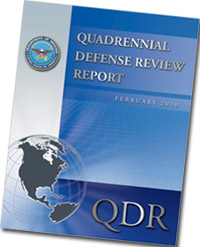Defense Department Says Climate Change is a Significant Threat to National Security
"Climate change … may act as an accelerant of instability or conflict, placing a burden to respond on civilian institutions and militaries around the world."
- Department of Defense's Quadrennial Defense Review (PDF)
In February 2010, the Department of Defense released the Quadrennial Defense Review (QDR), declaring that climate change will play a “significant role in shaping the future security environment.” This is the first time the QDR has directly addressed the national security threat from climate change in its planning.
In 2007, Sens. John Warner (R-VA) and Hillary Rodham Clinton (D-NY), members of the Senate Armed Services Committee, added language to the 2008 National Defense Authorization Act requiring DoD to consider the effects of climate change on DoD facilities, capabilities and missions. Through the QDR, DoD is now considering and incorporating the threat of climate change in its long-range strategic plans.
A Strategy-Driven Process
 DoD conducted the 2010 QDR from February 2009 through January 2010, beginning with an assessment of the emerging security landscape and the many ways in which the U.S. armed forces may be called on to protect and advance the nation's interests. In order to determine the mix of military capabilities best suited to supporting the nation's defense strategy, the QDR was analytically grounded. Secretary of Defense Robert M. Gates, advised by senior civilian and military leaders within the department, reviewed, modified and endorsed a set of scenarios that the QDR used to help evaluate current and potential future forces . The review provides the blueprint for what DoD will do over the next four years.
DoD conducted the 2010 QDR from February 2009 through January 2010, beginning with an assessment of the emerging security landscape and the many ways in which the U.S. armed forces may be called on to protect and advance the nation's interests. In order to determine the mix of military capabilities best suited to supporting the nation's defense strategy, the QDR was analytically grounded. Secretary of Defense Robert M. Gates, advised by senior civilian and military leaders within the department, reviewed, modified and endorsed a set of scenarios that the QDR used to help evaluate current and potential future forces . The review provides the blueprint for what DoD will do over the next four years.
According to Michèle Flournoy, undersecretary of defense for policy, “The QDR may be the most important report DoD provides Congress. It really requires the department to step back and think strategically about the present and the future to set its priorities and objectives and then to connect those to the program and to the budget.”
The QDR, Energy and Climate Change
According to the 2010 QDR, climate change “will shape the operating environment, roles, and missions” that the department undertakes, and “DoD will need to adjust to the impacts of climate change on our facilities and military capabilities.”
Among the report's highlights related to climate change:
- “Although they produce distinct types of challenges, climate change, energy security, and economic stability are inextricably linked.” (Page 84)
- “While climate change alone does not cause conflict, it may act as an accelerant of instability or conflict, placing a burden to respond on civilian institutions and militaries around the world.” (Page 85)
- “[T]he Department must complete a comprehensive assessment of all installations to assess the potential impacts of climate change on its missions and adapt as required.” (Page 85)
- “The Environmental Security and Technology Certification Program uses military installations as a test bed to demonstrate and create a market for innovative energy efficiency and renewable energy technologies coming out of the private sector and DoD and Department of Energy laboratories.” (Page 86)
- “DoD must incorporate geostrategic and operational energy considerations into force planning, requirements development, and acquisition processes. To address these challenges, DoD will fully implement the statutory requirement for the energy efficiency Key Performance Parameter and fully burdened cost of fuel set forth
in the 2009 National Defense Authorization Act.” (Page 87) - “The Department will also investigate alternative concepts for improving operational energy use, including the creation of an innovation fund administered by the new Director of Operational Energy to enable components to compete for funding on projects that advance integrated energy solutions.” (Page 87)
- “The Department is increasing its use of renewable energy supplies and reducing energy demand to improve operational effectiveness, reduce greenhouse gas emissions in support of U.S. climate change initiatives, and protect the Department from energy price fluctuations.” (Page 87)
To read the full climate section of the QDR, visit:
www.defense.gov/QDR /images/QDR _as_of_12Feb10_1000.pdf#page=107.











